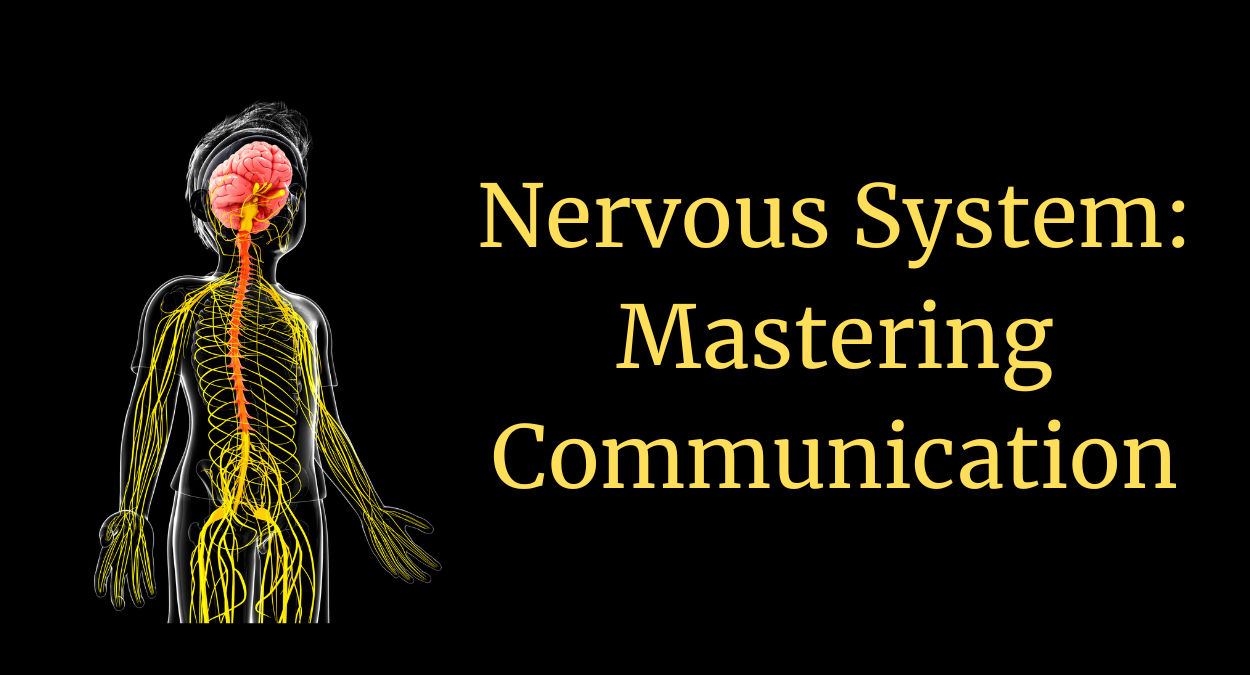Nervous System: Mastering Communication
The nervous system is a complex and intricate network within the human body, functioning as the master controller for communication and coordination. This remarkable system plays a pivotal role in transmitting signals, enabling us to sense, process information, and respond to the world around us.
Explanation of the Nervous System
The nervous system can be likened to the body’s information highway, responsible for transmitting signals between different parts of the body and the brain. It comprises specialized cells called neurons, which communicate through electrical impulses and chemical signals. The nervous system is instrumental in regulating various bodily functions, from simple reflexes to complex cognitive processes.

Nervous System: Mastering Communication
Divisions: Central and Peripheral
The nervous system is divided into two main components: the central nervous system (CNS) and the peripheral nervous system (PNS).
1. Central Nervous System (CNS)
Components: Consists of the brain and spinal cord.
Function: Acts as the central command center, processing information, and generating responses.
2. Peripheral Nervous System (PNS)
Components: Includes all nerves and ganglia outside the CNS.
Function: Connects the CNS to the rest of the body, facilitating communication between the brain and various organs and tissues.
The PNS further divides into the somatic nervous system, governing voluntary movements and sensory perception, and the autonomic nervous system, regulating involuntary bodily functions like heartbeat and digestion.

Nervous System: Mastering Communication
Importance in Transmitting Signals
The nervous system’s primary function is to transmit signals, allowing for rapid communication and coordination. This process involves several key steps:
1. Sensory Input
Process: Specialized receptors detect stimuli (such as touch, light, or temperature) in the environment.
Transmission: Sensory neurons transmit signals from the receptors to the CNS.
2. Integration
Process: The CNS processes the incoming signals, integrating information and generating appropriate responses.
Involvement: This step occurs in the brain, where complex processing and decisionmaking take place.
3. Motor Output
Process: Motor neurons convey signals from the CNS to muscles or glands, initiating a response.
Response: Muscles contract or relax, and glands release hormones or other substances.
This intricate signaling process allows the body to react swiftly to stimuli, whether it’s withdrawing a hand from a hot surface or formulating a complex thought.

Nervous System: Mastering Communication
The Symphony of Signaling
Picture the nervous system as a grand symphony, where neurons play the roles of instruments, creating a harmonious flow of signals. The CNS orchestrates this symphony, directing the melody of movements, thoughts, and responses throughout the body.
Understanding the significance of the nervous system sheds light on its role in maintaining homeostasis, ensuring our bodies respond appropriately to internal and external changes. As we explore the wonders of human physiology, the nervous system stands as the maestro, conducting the intricate communication that defines our experience and interaction with the world.
FAQs about the Nervous System:
1. Q: What is the Nervous System, and what is its primary function?
A: The Nervous System is a complex network of nerves and cells that transmit signals between different parts of the body. Its primary function is to coordinate and regulate various physiological processes and respond to external stimuli.
2. Q: What are the main components of the Nervous System?
A: The Nervous System consists of the Central Nervous System (brain and spinal cord) and the Peripheral Nervous System (nerves outside the brain and spinal cord).
3. Q: How does the Nervous System transmit signals, and what are neurons?
A: Neurons, the basic units of the Nervous System, transmit signals through electrical impulses. These impulses travel along the axons of neurons and are transmitted between neurons via synapses.
4. Q: What is the role of the Central Nervous System (CNS) in the Nervous System?
A: The CNS, comprised of the brain and spinal cord, processes and interprets sensory information, initiates responses, and controls higher mental functions such as memory and learning.
5. Q: How does the Peripheral Nervous System (PNS) contribute to the Nervous System?
A: The PNS includes nerves that connect the CNS to the rest of the body. It controls voluntary movements (somatic nervous system) and involuntary functions (autonomic nervous system).
6. Q: What are the major divisions of the Autonomic Nervous System (ANS), and what do they control?
A: The ANS has two divisions: the sympathetic nervous system (fight or flight response) and the parasympathetic nervous system (rest and digest response), which regulate involuntary bodily functions.
7. Q: How does the Nervous System control movement and coordination?
A: The Nervous System controls movement through the interaction of the brain, spinal cord, and peripheral nerves. Motor neurons convey signals from the CNS to muscles, coordinating voluntary actions.
8. Q: What is the role of the sensory nervous system, and how does it perceive the environment?
A: The sensory nervous system receives input from sensory organs and transmits this information to the CNS. It allows us to perceive and respond to our environment.
9. Q: Can the Nervous System be affected by disorders, and what are common neurological conditions?
A: Yes, neurological disorders can impact the Nervous System. Common conditions include Alzheimer’s disease, Parkinson’s disease, multiple sclerosis, and epilepsy.
10. Q: How can one maintain a healthy Nervous System, and what lifestyle factors contribute to neurological well-being?
A: A balanced diet, regular exercise, sufficient sleep, and stress management contribute to maintaining a healthy Nervous System.
Understanding the Nervous System is crucial for comprehending how the body perceives, processes information, and responds to stimuli.
- https://nursingscholar101.com/digestive-system-fuelling-the-body/
- Cardiovascular System And Respiratory System form 2 intricate networks
- Muscular System, Listing all 600 muscles in the human body
- The Marvel of Human Body Systems and Organs: Skeletal System, 10 FAQs
- Human Body Systems and Organs: A Marvellous





